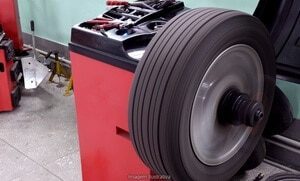How Much Does Wheel Balancing Cost?
Last Updated on December 23, 2023
Written by CPA Alec Pow | Content Reviewed by ![]() CFA Alexander Popinker
CFA Alexander Popinker
Smooth tire wear and improved handling depend on properly balanced wheels. But how much does wheel balancing cost? This guide goes over wheel balancing costs, weighs rotating against balancing, and suggests ways to save on supplies and shop fees.
How Much Does Wheel Balancing Cost?
Wheel balancing refers to evenly distributing weight across a tire and wheel assembly so it spins without vibration at high speeds. The cost of wheel balancing services is around $50 per wheel on average or around $200 for a whole typical sedan. Tire balancing on larger trucks will cost $100+ per tire.
Prices differ marginally by region and most shops charge per wheel rather than per axle. Balancing ensures safe steering and braking and extends tire life mileage.
Tire Balancing Prices
| Make and Model | Per Tire Price Range | Total Cost for Four Tires |
|---|---|---|
| Tesla Model S | $33 – $41 | $132 – $164 |
| Ram ProMaster 2500 | $26 – $33 | $104 – $132 |
| BMW 750i xDrive | $33 – $41 | $132 – $164 |
| Audi A4 | $33 – $41 | $132 – $164 |
| Jaguar XJ6 | $35 – $44 | $140 – $176 |
| Chevrolet K3500 | $26 – $33 | $104 – $132 |
| Dodge Nitro | $26 – $33 | $104 – $132 |
| Kia Cadenza | $26 – $33 | $104 – $132 |
| Mercedes-Benz C-Class | $33 – $41 | $132 – $164 |
| Subaru Outback | $26 – $33 | $104 – $132 |
| Mazda Protege | $26 – $33 | $104 – $132 |
| Ford Mustang | $26 – $33 | $104 – $132 |
| BMW 1 Series M | $33 – $41 | $132 – $164 |
| Toyota Camry | $26 – $33 | $104 – $132 |
| Honda Accord | $26 – $33 | $104 – $132 |
According to RepairPal, for example, tire balancing costs between $27 and $34 on average.
Yelp, on the other hand, states that wheel balancing costs vary greatly, ranging from $15 to $75 per tire, including the wheel weights and wheel balancing service.
Jiffy Lube lists a national average for a complete wheel alignment service between $50 to $168, with a front-end alignment typically costing anywhere from $50 to $75, and a four-wheel alignment costing $100 to $168.
How Wheel Rotations Differ from Tire Balancing
While related services, wheel balancing gets confused with tire rotations. Although both of them are very important, wheel alignment and balancing have different uses:
What is Wheel Balancing?
Wheel balancing evenly distributes weight around the wheel and tire assembly with the help of a balancing machine so it can spin straight at high speeds without vibration. Technicians attach small clipped weights at precise spots on the inner rim to offset heavier sections.
This adjustable balancing compensates for the minor differences in tire and wheel construction keeping ride quality smooth.
Consistent balancing every 5,000-6,000 miles when rotating tires enables extracting full tread life from them before a replacement becomes necessary. It also minimizes uneven tread wear that results from improper weight distribution. Expect to pay national shop average prices between $40-$75 per wheel for balancing services.
How Does Wheel Alignment Service Work?
Wheel alignment, also called front-end alignment, refers to adjusting the angles of wheels so they point perfectly straight rather than tilted in or out.
This positioning ensures the entire tire tread remains flat on the pavement so steering responds crisply without pulling to the side. It also eliminates rapid inner or outer tread edge wear from misalignment.
Do You Also Need A Wheel Alignment? Here’s How Much It Could Cost You
Many suspension system parts like ball joints, steering linkage, and struts gradually shift, causing misalignment over years of use. Front wheel drive vehicles in particular require occasional realignment as components age.
Drivers can expect a standard wheel alignment cost of $65-$100, while adjusting all four wheels may run closer to $130-$200.
Tire rotations every 5,000-8,000 miles ensure you get full mileage while balancing improves vibration, alignment, and safety.
Factors Influencing Wheel Balancing Costs
Numerous factors raise or lower the fees shops charge for balancing including:
Vehicle Type – Larger trucks with dual rear wheels cost over double typical cars for full-service balancing.
Tire Type – Larger off-road or heavy duty tires require more weight and effort to balance out, increasing fees.
Shop Fees – Major chains offer coupons and regular sale prices driving down costs while small independent garages usually charge full list rates consistently.
Location – Competitive urban regions with overlapping service providers foster reduced pricing from promotions while rural areas lack comparisons.
How Do Drivers Save on Wheel Balancing?
 Watch for shop promotions around holidays for discounted standard pricing. Also:
Watch for shop promotions around holidays for discounted standard pricing. Also:
Planning on Doing a Full Tune-Up For Your Car? This Is An Article About The Costs
Purchase Weights Yourself – Shops add huge markups on tiny weights they install. Providing your own slashes per tire costs, sometimes by half.
Learn DIY Skills – Self-balancing with home equipment returns the investment after several uses and frees you from shop scheduling.
Extend Tire Mileage – Consistent balancing enables extracting the full tread lifespan from a set before needing pricey replacements, saving hugely.
Obvious Signs You Need Tire Balancing
Spotting symptoms that indicate unbalanced wheels helps avoid handling issues plus uneven tire wear. Be on alert for:
- Vibrating Steering Wheel – Excess rotation vibration transfers through the column right to the driver’s hands most noticeably at highway speeds.
- Vehicle Pulling to One Side – Unbalanced tires want to always turn in a certain direction under power pulling the chassis off course.
- Spotty Tread Wear – Some sections of tread wear faster from added force on heavy areas of misaligned tires.
- Uneven Braking – Grabbing brakes or swerving during hard stops signals alignment problems from wheels pointed away from the center.
Take action as soon as one or more symptoms appear for inspection and correction to minimize later effects.
Preventing Frequent Tire Unbalancing
While balancing eventually becomes necessary, smart driving habits extend wheel balance life:
- Rotate Tires Every 5,000 Miles – Evens wear patterns that throw off balance.
- Inspect Tires Periodically – Catch embedded rocks and flaws that cause imbalances early.
- Drive on Quality Roads – Avoid potholes and debris which take a wheel balance toll.
Follow the car maintenance schedule in your owner’s manual for best results. Harsh drivers and rugged conditions accelerate the need for rebalancing.
Deciding When to Balance Wheels
Check Out This Article To Find Out The Cost To Reupholster a Car
Given the safety implications of unbalanced wheels, experts actually recommend preventative balancing every other time you get your tires rotated as part of comprehensive upkeep and preventive tire services.
Combine this proactive approach with watching for symptoms between rotations, being ready to request an inspection whenever the wheels seem off. Investing in timely balancing helps with improved vehicle handling, economical tire longevity, and most importantly accident prevention.
Properly balanced wheels provide a smoother ride that is also safer, and more economical mileage no matter your driving needs. Adjust budgets accordingly and take advantage of cost-cutting strategies for significant long-term savings potential.


Properly aligned wheels ensure your car handles properly, and therefore increases the life of your tyres and increases your safety.